#Crawler Camera Systems Market Forecast
Text
Crawler Camera Systems Market worth $191.4 Million | CAGR Rate 6.3% Forecast Period 2026
The industrial end user segment was accounted for revenue $50.2 Mn in 2018 and is expected to reach $77.2 million by 2026
According to a new report published by Allied Market Research titled, "Crawler Camera Systems Market by Product Type, End User, and Distribution Channel: Global Opportunity Analysis and Industry Forecast, 2019-2026," the global crawler camera systems market size was valued at $120.2 million in 2018 and is anticipated to reach $191.4 million by 2026 end with a CAGR of 6.3% during the forecast period. The market exhibit incremental revenue opportunity of $71.2 million from 2018-2026. North America & Europe dominated the market in 2019, accounting for 69.5% of the total crawler camera systems market share collectively.
Global Key Players:
The key players profiled in this crawler camera systems industry report include IBAK, Deep Trekker Inc., Rausch Electronics, Mini-Cam Ltd, CUES Inc., Inspector Systems Rainer Hitzel GmbH, iPEK International GmbH, AM Industrial (UK) Ltd., and Subsite Electronics. Other prominent players analyzed during the course of study are Inuktun Services Ltd., Kummert GmbH, Mini-Cam Ltd., Scanprobe, Spoutvac Industries, Envirosight LLC, Insight Vision Cameras among others.
The increasing incidence of pipeline damages across sewage pipelines, industrial drainage systems had boosted the demand of effective pipeline management. The pipelines inspection activity is mainly conducted to analyze the health of drainage systems, probable cause of blockages, corrosion management and other applications. The crawler cameras systems offers number of benefits to uses during pipeline inspection activity. These benefits include precision based imaging solution, real time monitoring of pipeline network, multi-function assessment through single device etc.
Get Sample Pages of Report: https://www.alliedmarketresearch.com/request-sample/6208
The trend of miniature pipeline inspection is gaining popularity across industrial inspection application. Miniature crawler inspection systems offers flexible options from small diameter pipeline to large network of pipes. These systems are compatible with multiple camera setups, longer tethers, and other images processing software. The versatility of these systems enables the inspection of tanks, small and medium pipes, ships, vessels, boreholes and similar type of spaces where camera inspection is required. The compact sized crawler camera systems are ideal for scheduled or emergency inspections in nuclear stations, petrochemical plants, refineries hydro-electric stations etc.
The crawler camera systems market is segmented on the basis of product type, end user, and region. Based on product type, the Crawler camera systems market is categorized into Camera, Crawler and Others.
The camera segment of the report account for highest revenue share in the overall market. The advancement in camera technologies and introduction of novel software platforms to analyze more complicated pipeline network. Furthermore, the manufacturers are introducing compact versions of their existing camera product line which is one of the key factor responsible for adoption of additional camera units among end users. The camera segment was valued at $57.7 million in 2019 and is expected to growth with a CAGR of 5.7% (2019-2026) to reach $191.4 million by 2026 growing at a CAGR of 6.3% during the forecast period. The crawler segment is anticipated to growth at a fastest CAGR owing to increased penetration of pipeline inspection technologies among residential and municipal end users.
Based on end user, the crawler camera systems market is segmented into residential end users, industrial end users, municipal end users. The industrial end user segment was accounted for revenue $50.2 Mn in 2018 and is expected to reach $77.2 million by 2026. The industrial end user segment comprised on various stakeholder including, nuclear stations, petrochemical plants, refineries hydro-electric stations, chemical plants, automotive and mechanical industries, etc.
Geographically, the global crawler camera systems market is analyzed across North America (U.S., Canada, and Mexico), Europe (Germany, France, Spain, Italy, and Rest of Europe), Asia-Pacific (China, India, Japan, Australia, South Korea, and Rest of Asia-Pacific), and LAMEA (Middle East, Latin America, and Africa). North America and Europe regions accounted for 69.5% share in terms of revenue in 2018. These regions have strong adoption of crawler camera systems due to substantial spending on pipeline maintenance compared with other regions. Moreover, the easy availability of auxiliary products and services related to crawler camera maintenance is also responsible for strong adoption of these systems in North America and Europe region.
Report Summary: https://www.alliedmarketresearch.com/crawler-camera-systems-market
Key Finding of The Crawler Camera Systems Market:
The camera systems products segment is expected to grow at a CAGR of 5.7% during the forecast period.
North America is anticipated to dominate the crawler camera systems market growth, registering a CAGR of 5.0%.
Asia-Pacific is projected to exhibit exponential growth throughout 2026, registering the highest of CAGR 9.0%.
The industrial end user segment is anticipated to dominate the global crawler camera systems market analysis, with a CAGR of 5.9% during the crawler camera systems forecast
period.
The residential end user segment is estimated to grow at a CAGR of 8.4% during the forecast period
#Crawler Camera Systems Market#Crawler Camera Systems Market Size#Crawler Camera Systems Market Share#Crawler Camera Systems Market Growth#Crawler Camera Systems Market Forecast
0 notes
Text
Crawler Camera System Market - Major Industry Growth Driving Factors
Crawler Camera System Market – Major Industry Growth Driving Factors
This report studies the Crawler Camera System Market with many aspects of the industry like the market size, market status, market trends and forecast, the report also provides brief information of the competitors and the specific growth opportunities with key market drivers. Find the complete Crawler Camera System Market analysis segmented by companies, region, type and applications in the…
View On WordPress
#Covid-19 Impact Analysis#Crawler Camera System#Crawler Camera System forecast#Crawler Camera System Industry#Crawler Camera System Market#Crawler Camera System price#Crawler Camera System report#Crawler Camera System research#Crawler Camera System share#Crawler Camera System trends
0 notes
Text

Crawler Camera System Market Anticipated to Witness High Growth Owing to Increasing Infrastructure Inspection Needs
Crawler camera systems, also known as pipe crawlers or micro duct cameras, are self-propelled inspection cameras used for non-destructive testing of pipelines, tunnels and confined spaces. These compact robotic systems consist of a lightweight camera head attached to multiple small wheels or legs that allow them to travel through narrow spaces. Crawler camera systems offer unique advantages over traditional manual inspection methods such as providing real-time images and video feed to remotely located operators, facilitating inspection of long pipelines without disruption of services, and ensuring safety of inspectors by eliminating the need to enter hazardous confined spaces.
The global crawler camera system market is estimated to be valued at US$ 154.3 Mn in 2024 and is expected to exhibit a CAGR of 8.0% over the forecast period 2024 to 2031.
Increasing investments in development and maintenance of underground pipelines and infrastructure are the primary factors driving the demand for crawler camera inspection systems. Rapid urbanization and growth of smart cities have also amplified the need for periodic condition assessment of pipelines used for transportation of water, gas and electricity. Adoption of crawler cameras helps structure owners to efficiently comply with safety regulations and schedules mandated for pipeline inspection.
Key Takeaways
Key players operating in the Global Crawler Camera System Market Companies are AM Industrial (UK) Ltd., CUES Inc., Deep Trekker Inc., Envirosight LLC, iPEK International GmbH, Inspector Systems Rainer Hitzel GmbH, Inuktun Services Ltd., Kummert GmbH, Mini-Cam Ltd., Rausch Electronics USA, LLC, ROVVER X (by Envirosight), Subsite Electronics, Trelleborg AB, and Tufftruk. These players are focusing on new product launches and expansion of sales and distribution networks globally to consolidate their market position.
Market Restraints
High initial costs: Crawler camera systems have high capital requirements owing to incorporation of advanced imaging sensors, robotic actuators and other control equipment. This acts as a barrier for small-scale users and renters.
Operational challenges: Adverse site conditions like poor lighting, presence of obstructions and debris inside pipelines pose challenges for maneuvering and positioning of crawler cameras during inspections. This often requires pre-inspection cleaning and equipment modifications.
Segment Analysis
The Global Crawler Camera System Market Growth dominating sub segment is the video snake camera sub segment. This is because video snake cameras have advanced capabilities such as swiveling cameras that allow operators to navigate around obstacles and inspect difficult to reach areas. They are commonly used for underground pipeline inspections to detect internal corrosion, cracks, leaks or blockages.
Global Analysis
Regionally, the North America region is expected to dominate the global crawler camera system market during the forecast period. This is because countries in the region like United States and Canada have established infrastructure and are focussed on repair and maintenance activities of sewer pipes and underground utilities. The presence of major players and advanced technologies is also driving the crawler camera system market in North America. Asia Pacific is anticipated to be the fastest growing region owing to rising infrastructure development activities and increasing industrialization in countries like China and India. Countries are making heavy investments in transport, power and water utilities which is augmenting the demand for crawler camera systems for inspection activities in the region.
Get more insights on Global Crawler Camera System Market
About Author:
Ravina Pandya, Content Writer, has a strong foothold in the market research industry. She specializes in writing well-researched articles from different industries, including food and beverages, information and technology, healthcare, chemical and materials, etc. (https://www.linkedin.com/in/ravina-pandya-1a3984191)
0 notes
Text
0 notes
Text
Crawler Camera System Market Size, Share, Growth, Analysis and Forecast Report, 2019-2027
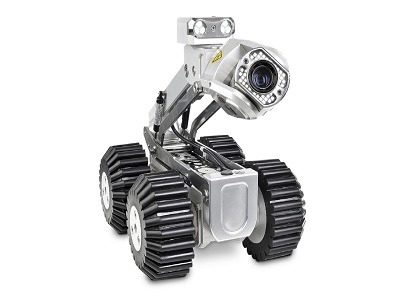
The latest market report published by Credence Research, Inc. The crawler camera systems market worldwide is expected to grow at a CAGR of 6.70% during the forecast period from 2019 to 2027.
The modern world thrives on innovative technological solutions, and the Crawler Camera Systems market is a testament to this evolution. Characterized by its unique ability to inspect and navigate confined spaces, the Crawler Camera System offers a blend of robotics and advanced imaging capabilities. As industries strive for enhanced efficiency and accuracy, the market for these systems continues to expand, and for a good reason.
Traditionally, visual inspection of challenging environments, such as underground pipelines, ducts, and sewers, involved significant manual labor and was fraught with hazards. Enter the Crawler Camera System - a remotely operated vehicle equipped with high-resolution cameras and often complemented by other sensors. Its primary value proposition is ensuring a detailed, accurate, and safe assessment of even the most inaccessible areas. Industries such as waste management, construction, and infrastructure development have especially benefitted from these systems, resulting in improved maintenance practices and reduced downtimes.
Browse the Full Report: https://www.credenceresearch.com/report/crawler-camera-systems-market
0 notes
Text
Crawler Camera System Market Share, trends and Analysis Report by 2030
The novel offering by The Insight Partners on- “ Crawler Camera System Market Industry Analysis| 2030” unfolds different prospects of the market. This market study provides an overview of the industry and later dives into details such as market size, shares, CAGR estimates, and revenue forecasts. The research is capable of providing a thorough understanding of key drivers and challenges ahead of manufacturers. Alongside, this further sheds light on some key trends Crawler Camera System manufacturers can leverage for a competitive edge in the industry.
The report offers a thorough account concerning future progressions drawn from the past information and current conditions of the market. It gives a comprehensive perspective on the worldwide Crawler Camera System market to settle on smart choices concerning future changes. This report is the outcome of detailed scrutiny of industry changes, inputs from key participants, and verified statistics representing actionable insights. Central participants contend in the Worldwide market are - [AM Industrial (UK) Ltd., CUES Inc., Deep Trekker Inc., INSPECTOR SYSTEMS Rainer Hitzel GmbH, Inuktun Services Ltd., iPEK International GmbH, Kummert GmbH, Mini-Cam Ltd. (Halma company), Rausch Electronics USA, LLC, Subsite Electronics].
Your free sample is just a click away!- https://www.theinsightpartners.com/sample/TIPRE00004648/

Our Research Methods:
This syndicated research is crafted using Primary Research, Secondary Research, Company Share Analysis, and Model (including Demographic information, Macro-financial pointers, graphical information, and Industry markers: Expenditure, framework, area development, and offices).
Both subjective and quantitative data are included in the research after validation for facts. To calculate the Crawler Camera System market size, the report considers the income formed from the deals of the market suppliers. The income created from the deals of the market is determined through essential and optional exploration. The vital participants working in the market across the globe are recognized through optional examination and a definite investigation of the top players in the market is accomplished.
Shares of key market players are taken into consideration while projecting overall industry growth. Just as an investigation of the incomes of organizations for the last three to five years additionally gives the base for determining the market size (2030) and its development rate. This Crawler Camera System Market Report covers worldwide, provincial, and nation-level market size, pieces of the overall industry
Exclusive COVID-19 Impact Analysis
A brief account of COVID-19 impact analysis is a unique feature of this research. This section exclusively takes you through supply chain dynamics, distribution strategies, and a range of business responses. This study goes the extra mile to add projections on the post-pandemic recovery of the Crawler Camera System market. Estimates are recorded in association with the cusp of transformation the industry has undergone during the COVID-19 pandemic.
Crawler Camera System Market Segmentation
In this dedicated section of the report, readers are presented with decisive clarity toward highlighting the most effective segment that enables heavy revenue flow. Relevant details about other market segments are also discussed in the report to derive logical conclusions about the most prominent segments in the global Crawler Camera System market.
Based on Component of Crawler Camera System Market Research report:
Crawler
Camera
Control Units
Cable Drum
Based on Application of Crawler Camera System Market Research report:
Drain Inspection
Pipeline Inspection
Tank Void Cavity
Conduit Inspection
Based on End-Users of Crawler Camera System Market Research report:
Residential
Commercial
Municipal
Industrial
Based on Regions:
North America (U.S., Canada, Mexico)
Europe (U.K., France, Germany, Spain, Italy, Central & Eastern Europe, CIS)
Asia Pacific (China, Japan, South Korea, ASEAN, India, Rest of Asia Pacific)
Latin America (Brazil, Rest of Latin America)
The Middle East and Africa (Turkey, GCC, Rest of the Middle East and Africa)
Rest of the World…
Perks of Choosing this Research:
Graphical presentation of global as well as regional investigation
A brief introduction to the Research and Business Overview of the market
Selected illustrations of market trends
Example pages from the Crawler Camera System market report
Syndicate Market Research Methodology
About Us:
The Insight Partners is a market research solution and consultation company. Specializing in syndicate market research, our team helps clients in their hunt for revenue pockets in several industries. A team of 250+ research experts is dedicated to offering the most relevant, data-driven, and trustworthy market insights and consultation.
Contact Us:
If you have any queries about this report or if you would like further information, please contact us:
The Insight Partners
Phone: +1-646-491-9876
E-mail: [email protected]
0 notes
Link
0 notes
Text
Canada Frozen Fish and Seafood Market 2023 <growth trends, size, share, opportunities, revenue> 2023-2030
https://theprose.com/post/714410/europe-sailing-dinghies-market-challenges-opportunities-size-sharehttps://theprose.com/post/714411/europe-downwind-sails-market-2023-booming-across-globe-by-segmentshttps://theprose.com/post/714412/usa-boat-roller-bearing-blocks-market-analysis-by-leading-manufacturers-2023-2029https://theprose.com/post/714414/europe-turnbuckles-market-2023-2029-explained-effective-movementshttps://theprose.com/post/714416/usa-boat-snap-shackles-market-hitting-new-heights-between-2023-2029https://theprose.com/post/714417/europe-boat-steering-wheel-pedestals-market-outlines-the-growth-factors-2029https://theprose.com/post/714419/usa-boat-depth-sounders-market-2023-latest-trending-industry-is-booming-globallyhttps://theprose.com/post/714421/europe-marine-audio-stereos-market-outlook-2023-size-players-cost-structureshttps://theprose.com/post/714423/usa-boat-engine-brackets-market-report-pointing-to-capture-growth-2029https://theprose.com/post/714427/europe-boat-engine-mounts-marketstatistics-industry-planning-structurehttps://theprose.com/post/714428/usa-fuel-tank-indicators-market-2023-size-share-trends-growthhttps://theprose.com/post/714430/europe-boat-helm-seats-market-future-scope-demands-2029https://theprose.com/post/714433/usa-tower-internals-market-to-witness-huge-growth-by-2029https://theprose.com/post/714435/usa-slag-remover-market-2029-growing-rapidly-with-latest-trendhttps://theprose.com/post/714437/europe-multifinger-imaging-toolmit-market-2023-demand-future-scopehttps://theprose.com/post/714439/usa-copper-nickel-zinc-alloy-market-advancing-the-growth-globally-by-trendshttps://theprose.com/post/714441/europe-conductor-etch-system-market-2023-overview-forecast-study-2029https://theprose.com/post/714443/europe-pvc-waterstop-market-segmented-by-type-application-end-userhttps://theprose.com/post/714445/europe-marine-vfd-market-challenges-opportunities-size-sharehttps://theprose.com/post/714447/europe-healthcare-education-solutions-market-2023-booming-across-globe-by-segmentshttps://theprose.com/post/714448/usa-brand-protection-solutions-market-analysis-by-leading-manufacturers-2023-2029https://theprose.com/post/714449/europe-industrial-battery-chargers-market-2023-2029-explained-effective-movementshttps://theprose.com/post/714450/usa-machine-learning-in-medicine-market-hitting-new-heights-between-2023-2029https://theprose.com/post/714451/europe-manual-optical-lens-edger-market-outlines-the-growth-factors-2029https://theprose.com/post/714452/usa-shrinkable-lidding-films-market-2023-latest-trending-industry-is-booming-globallyhttps://theprose.com/post/714453/europe-crawler-camera-system-market-outlook-2023-size-players-cost-structureshttps://theprose.com/post/714454/usa-pharmacopoeial-grade-methylene-blue-market-report-pointing-to-capture-growth-2029https://theprose.com/post/714455/europe-temperature-control-units-tcu-marketstatistics-industry-planning-structurehttps://theprose.com/post/714457/usa-yttria-stabilized-zirconia-ysz-market-2023-size-share-trends-growthhttps://theprose.com/post/714458/usa-yttria-stabilized-zirconia-ysz-market-2023-size-share-trends-growth
0 notes
Text
Crawler Camera System Market Set to Grow at the Fastest Rate- Time to Grow your Revenue
Crawler Camera System Market Set to Grow at the Fastest Rate- Time to Grow your Revenue
The report “Crawler Camera System Market by Component (Hardware, Software, Service), Application (Drain Inspection; Pipeline Inspection; Tank, Void, and Cavity/Conduit Inspection), Vertical (Residential, Municipal, Industrial), and Region – Global Forecast to 2025″, is projected to reach USD 353 million by 2025 from USD 145 million in 2019; it is projected to grow at a CAGR of 14.5% during the…
View On WordPress
0 notes
Text
Crawler Camera System Market - Boosting The Growth Worldwide forecast to 2030
Crawler Camera System Market – Boosting The Growth Worldwide forecast to 2030
According to a new market research report published by Transparency Market Research the global crawler camera system market is expected to reach value of US$ 187.6 Mn by 2027, expanding at a CAGR of 3.6% from 2019 to 2027. According to the report, the market would continue to be influenced by a range of macroeconomic and market-specific factors. In terms of demand, North America is likely to…

View On WordPress
0 notes
Text
Crawler Camera System Market valued $191.4 million - IBAK, Deep Trekker Inc., Rausch Electronics, Mini-Cam Ltd
According to a new report published by Allied Market Research titled, "Global Crawler Camera Systems Market by Product Type, End User, and Distribution Channel: Global Opportunity Analysis and Industry Forecast, 2019-2026," the global crawler camera systems market size was valued at $120.2 million in 2018 and is anticipated to reach $191.4 million by 2026 end with a CAGR of 6.3% during the forecast period. The market exhibit incremental revenue opportunity of $71.2 million from 2018-2026. North America & Europe dominated the market in 2019, accounting for 69.5% of the total crawler camera systems market share collectively.
Key Finding of The Crawler Camera Systems Market:
The camera systems products segment is expected to grow at a CAGR of 5.7% during the forecast period.
North America is anticipated to dominate the crawler camera systems market growth, registering a CAGR of 5.0%.
Asia-Pacific is projected to exhibit exponential growth throughout 2026, registering the highest of CAGR 9.0%.
The industrial end user segment is anticipated to dominate the global crawler camera systems market analysis, with a CAGR of 5.9% during the crawler camera systems forecast
period.
The trend of miniature pipeline inspection is gaining popularity across industrial inspection application. Miniature crawler inspection systems offers flexible options from small diameter pipeline to large network of pipes. These systems are compatible with multiple camera setups, longer tethers, and other images processing software. The versatility of these systems enables the inspection of tanks, small and medium pipes, ships, vessels, boreholes and similar type of spaces where camera inspection is required. The compact sized crawler camera systems are ideal for scheduled or emergency inspections in nuclear stations, petrochemical plants, refineries hydro-electric stations etc.
The crawler camera systems market is segmented on the basis of product type, end user, and region. Based on product type, the Crawler camera systems market is categorized into Camera, Crawler and Others.
Get Free Sample Pages @ https://www.alliedmarketresearch.com/request-sample/6208
The camera segment of the report account for highest revenue share in the overall market. The advancement in camera technologies and introduction of novel software platforms to analyze more complicated pipeline network. Furthermore, the manufacturers are introducing compact versions of their existing camera product line which is one of the key factor responsible for adoption of additional camera units among end users. The camera segment was valued at $57.7 million in 2019 and is expected to growth with a CAGR of 5.7% (2019-2026) to reach $191.4 million by 2026 growing at a CAGR of 6.3% during the forecast period. The crawler segment is anticipated to growth at a fastest CAGR owing to increased penetration of pipeline inspection technologies among residential and municipal end users.
Based on end user, the crawler camera systems market is segmented into residential end users, industrial end users, municipal end users. The industrial end user segment was accounted for revenue $50.2 Mn in 2018 and is expected to reach $77.2 million by 2026. The industrial end user segment comprised on various stakeholder including, nuclear stations, petrochemical plants, refineries hydro-electric stations, chemical plants, automotive and mechanical industries, etc.
Geographically, the global crawler camera systems market is analyzed across North America (U.S., Canada, and Mexico), Europe (Germany, France, Spain, Italy, and Rest of Europe), Asia-Pacific (China, India, Japan, Australia, South Korea, and Rest of Asia-Pacific), and LAMEA (Middle East, Latin America, and Africa). North America and Europe regions accounted for 69.5% share in terms of revenue in 2018. These regions have strong adoption of crawler camera systems due to substantial spending on pipeline maintenance compared with other regions. Moreover, the easy availability of auxiliary products and services related to crawler camera maintenance is also responsible for strong adoption of these systems in North America and Europe region.
Report Summary: https://www.alliedmarketresearch.com/crawler-camera-systems-market
Global Key Players:
The key players profiled in this crawler camera systems industry report include IBAK, Deep Trekker Inc., Rausch Electronics, Mini-Cam Ltd, CUES Inc., Inspector Systems Rainer Hitzel GmbH, iPEK International GmbH, AM Industrial (UK) Ltd., and Subsite Electronics. Other prominent players analyzed during the course of study are Inuktun Services Ltd., Kummert GmbH, Mini-Cam Ltd., Scanprobe, Spoutvac Industries, Envirosight LLC, Insight Vision Cameras among others.
The increasing incidence of pipeline damages across sewage pipelines, industrial drainage systems had boosted the demand of effective pipeline management. The pipelines inspection activity is mainly conducted to analyze the health of drainage systems, probable cause of blockages, corrosion management and other applications. The crawler cameras systems offers number of benefits to uses during pipeline inspection activity. These benefits include precision based imaging solution, real time monitoring of pipeline network, multi-function assessment through single device etc.
#Crawler Camera System Market#Crawler Camera System Market Size#Crawler Camera System Market Share#Crawler Camera System Market Growth#Crawler Camera System
0 notes
Text
Crawler Camera System Market 2021: Applications, Specifications, Top Players: Deep Trekker, Inuktun Services Ltd, iPEK International, Kummert GmbH, Mini-Cam, Rausch Electronics, Subsite Electronics
Crawler Camera System Market 2021: Applications, Specifications, Top Players: Deep Trekker, Inuktun Services Ltd, iPEK International, Kummert GmbH, Mini-Cam, Rausch Electronics, Subsite Electronics
Recently Published Report on Crawler Camera System Market by Axel Reports includes market overview, detailed literature on products, services and overall industry scenario by 2027. The key categories covered in the market segmentation are region, applications and key players. It is considering the year 2021 as a base year and forecast period for predicting the growth of the market is 2021-2027.…
View On WordPress
0 notes
Text
Fulfill Untapped Customer Demands Through Your Faceted Navigation
Faceted navigation allows customers to narrow down search results based on specific product attributes. They typically exist on Product Listing Pages (PLPs) and are a great way to help users intuitively discover products but managing this filtering system is a common SEO challenge. Crawling and indexation need to be controlled.
However, if we look beyond their inherent functionality, facets can offer us considerable potential. By centering your secondary navigation on long-tail keyword opportunities, you’ll be able to strategically utilize consumer intent, secure additional web conversions, and boost revenue levels.
Match consumer intent with long-tail search queries
Having an established brand and a solid domain backlink profile won’t guarantee success. This is great news for smaller brands, as industry giants aren’t necessarily going to win at this game.
If we search for “long sleeve wedding dresses”, we can see how David’s Bridal’s optimized facet page (Domain Authority: 67/100, Page Authority: 47 / 100) has obtained the top ranking position, while Nordstrom’s result (Domain Authority: 87/100, Page Authority: 39/100) appears in the third position for this particular query. We’ll take a look at what makes this page so effective later.
When looking at how we can optimize faceted navigations, it’s important to recognize that product attributes convey consumer needs and aspirations. If, for example, I’m looking for a wedding dress, then I may tailor my search by the color, fabric, neckline shape, and the sleeve length.
According to the search demand curve, long-tail queries account for up to 70% of all organic searches. They are highly targeted queries that offer big traffic-driving opportunities.
In the last few years, we’ve seen a big shift in the industry towards capitalizing this intent with long-form content. Blog articles and style guides have become the go-to methods for many to capture these visitors, as we can see from the examples taken from Marks & Spencers’ "Inspire Me" section:

People often look for inspiration when they’re shopping, and these pages provide an effective way to add more internal links to category and product pages. But relying on this approach is one-dimensional, given that these deeper content pages tend to have lower PageRank. An extensive amount of time and effort will, therefore, be required to achieve the desired result.
In comparison, Product Listing Pages usually target broader search terms, and faceted navigations typically exist as passive functions. This is because they’re often blocked from crawlers, making them devoid of any SEO value. Waterstones (a well-known British bookstore) is one retailer that applies this rule for their on-page filters:
In this particular example, I’ve applied a filter to only show me books for 5 – 8 year olds, but the appended URL (https://ift.tt/3xrpOJS) is blocked in the robots.txt file. This is going to prevent such pages from being served in the SERPs despite them having the potential to meet specific customer needs. This shows that there can be a fundamental disconnect in matching customer intent to the pages we’re providing them in the organic results.
From the diagram below, we can see how editorial content typically focuses on the “awareness” and “interest” stages, whilst Product Listing Pages tend to be more in line with the “consideration” and “purchase” phases:
Serving the right content to users throughout their buying journey is pivotal to success. For many retailers, competitors are continuing to prioritize broader, high-volume keywords in saturated markets. They’re targeting the same terms to secure a proportion of the same search traffic. This is a very challenging prospect to face, and without carving out a gap in the marketplace, they won’t necessarily deliver the results they seek to secure. Likewise, relying on informational guides to target long-tail keywords means that you’re missing a large percentage of users who have very specific buying requirements. Yes, they’re ready to make a purchase!
By shifting your focus to address your customer’s real needs and expectations, you’ll be able to deliver a satisfying, frictionless experience at every interaction and all the way through to that final purchase.
The solution
Step 1: Conduct long-tail keyword research
Build a really comprehensive view of your potential customers by harnessing data from a variety of sources, including:
a) Keyword research tools like Moz, Google Keyword Planner, and Answer The Public.
b) The SERPs — get inspiration from the auto-suggest results, People Also Ask, and the related search links at the bottom of the page.
c) Competitor activity — aside from using SEO monitoring software, you can use a data mining extension tool like Scraper, which will extract faceted options directly from competitor Product Listing Pages. These tools are often free to download and allow you to quickly transfer product categories.
d) Your Google Search Console, Analytics, and PPC accounts to determine which keywords and URLs are securing the highest number of visits and web conversions. Internal search data can also give you great consumer insights.
e) Speak to your merchandising team to understand product demands and fulfillment capabilities.
Step 2: Group into meaningful sub-topics
Once you’ve collated all this information into a spreadsheet, you’ll be able to discover long-tail, consideration-orientated keywords. While individually they may not boast huge monthly search estimates, they can collectively highlight where purchase intentions can be better fulfilled.
To help illustrate this point, we can look at a small subset of lingerie keywords and the facets the searches represent:

From the table above we can quickly see a pattern emerging with color and material variations appearing across the search terms. We can then substantiate this information with session and revenue estimates with the use of a recognized CTR model. This enables us to help forecast the potential organic uplift and quantify the size of the prize for a number of different scenarios that are on offer from each new facet combination. This may include estimations for securing position 10, 7, 5, 3 and 1 in Google.
One thing to note here is that it’s worth excluding synonyms, as they will falsely inflate your calculations. An example here would be to exclude “storage drawers” (22.2k monthly searchers) when reviewing the performance for “chest of drawers” (201k m/s). Including both variants will cause a false positive result and will lead you to draw incorrect conclusions.
Step 3: Dig deeper into broader terms around offers, ratings, and price
These product filters are found in the “Sort” dropdown box and, from my experience, these are set to “noindex” from the outset as they simply allow users to re-order page results. Certainly, content management systems like Shopify and Shopware have this as a default.
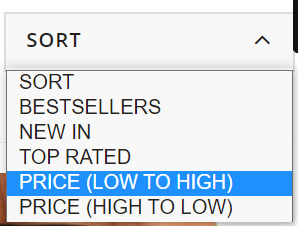
This makes sense since their purpose is to allow visitors to simply sort or narrow page content rather than offering alternative results and additional value (which is offered through faceted navigation). As such, filter typically produce duplicate results which should not be discoverable beyond the immediate moment. But this hard-and-fast rule doesn’t always apply perfectly in the real world. This is why we need to look at our individual industries and understand what’s important to our unique set of customers.
If we look at the world of gifting, we often see people shopping with a particular budget in mind. Therefore, terms like “birthday gift under £20” (40 m/s) or “Secret Santa gift under £10” (2.9k m/s) are reasonably common, and opening up relevant listing pages could be useful for shoppers.
Step 4: The technical steps
Facet taxonomies are hugely complex and the number of attributes that can be strung together increases with the size of the domain. We, therefore, need to carefully manage the flood gates and mitigate against any potential risks including crawl inefficiencies and link equity dilution.
We can do this by:
1. Avoiding thin/doorway pages by regularly re-assessing your product offering. For instance, you may consider there to be little value in creating a new listings page if you’re selling a very small range of low price point products. In this case, you may decide against opening up an additional Product Listing Page when you sell as few as 10 eligible products. However, this is not a fixed rule, so it’s quite possible that your criteria may be lower for particular product lines. Either way, these numbers will change over time. Consider seasonal trends, when new collections are launched, and when they become discontinued. Setting up a product retirement strategy to manage expired products and categories at scale in parallel with this step is also highly recommended.
2. Prevent content cannibalization by arranging selected facets according to their value and significance. “Size” is very important for some electrical goods like TVs, laptops, and cameras, but is less so for beauty accessories or vacuum cleaners. You must also make sure page content is distinctive and reflects the focus of your chosen facet(s). Refer to step 5 for more details.
3. Follow the sequence in which adjectives and facets are typically selected by your customers. This can vary depending on where your audience lives. So, whilst products generally have five or more distinguishable features, English vernacular determines that we use more than four adjectives (e.g. size + color + material + shape) to describe something.
4. Control the controllables by dealing with overlapping variations. This typically occurs when multiples co-exist and each exhibits good search metrics. For instance, it’s reasonable for someone to simultaneously look for several color and/or fabric combinations in the different ways below.
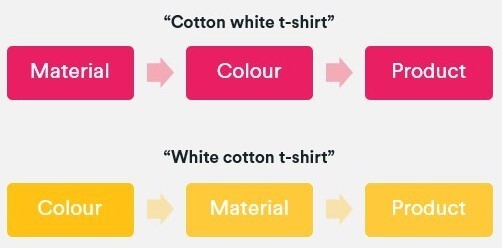
When this situation occurs, we should follow the same linguistic rules as above and choose a preferred sequence. In this case, it would be color + material + product type.
In comparison to the noindex tag suggested for on-page filters you should canonicalize unnecessary facets to their parent page (remembering that this is merely a hint and not a directive). This will enable you to control how crawlers deal with highly comparable result pages and will, therefore, help to prevent your site from being demoted in the SERPs. Dynamic search parameters should continue to be defined with a “noindex, nofollow” meta robots tag, disallowed in the robots.txt file, and configured through Google’s URL parameter tool (within your Search Console account) to tell crawlers the purpose of your parameters and how you would like them to be treated. This is a helpful guide on parameter handling for Googlebots, but bear in mind that this last tip won’t influence how Bing or Yahoo user-agents interpret these pages.
5. Open your facets in phases and cultivate it into a test-and-learn process. This will enable you to identify issues a lot sooner and implement facet-wide solutions in a timely manner. Without having to unravel these additional layers of complexity, problems such as crawl inefficiencies, PageRank dilution, or excessive indexation can be swiftly resolved.
To show you what this could look like, I’ve provided a phasing plan that was created for one of our e-commerce clients. Our research showed a significant SEO opportunity for opening up some of the facets and filters: potential +£263Kpcm for the “colour + type” facet (UK):
What’s more, when we extended our forecast to include other facet combinations, we calculated an additional revenue opportunity of up to +£207K/pcm (before filtering out combinations with no products offering).
Step 5: Optimize your facet URLs
Optimize your new facet category URLs to establish relevancy for your selected search terms. The key on-page elements to focus on include:
URL
Page title
Breadcrumb anchor texts
H tags
Content snippets (e.g. introductory text and FAQ copy)
Image ALT texts
Product names
Link out to similar facet category pages (i.e. via a “You May Also Like” feature box)
David’s Bridal is a good example of a retailer that has done this well. Looking back at the ‘Long Sleeve Wedding Dress’ Product Listing Page, we can see that they’ve curated unique content and followed fundamental optimization tactics on the landing page in a way that feels helpful to the user.
URL: davidsbridal.com/long-sleeve-wedding-dresses
Page Title: Long Sleeve Wedding Dresses & Gowns | David's Bridal
Meta Description: Do you dream of wearing a long sleeve wedding dress on your big day? Shop David's Bridal wide variety of wedding gowns with sleeves in lace & other designs!
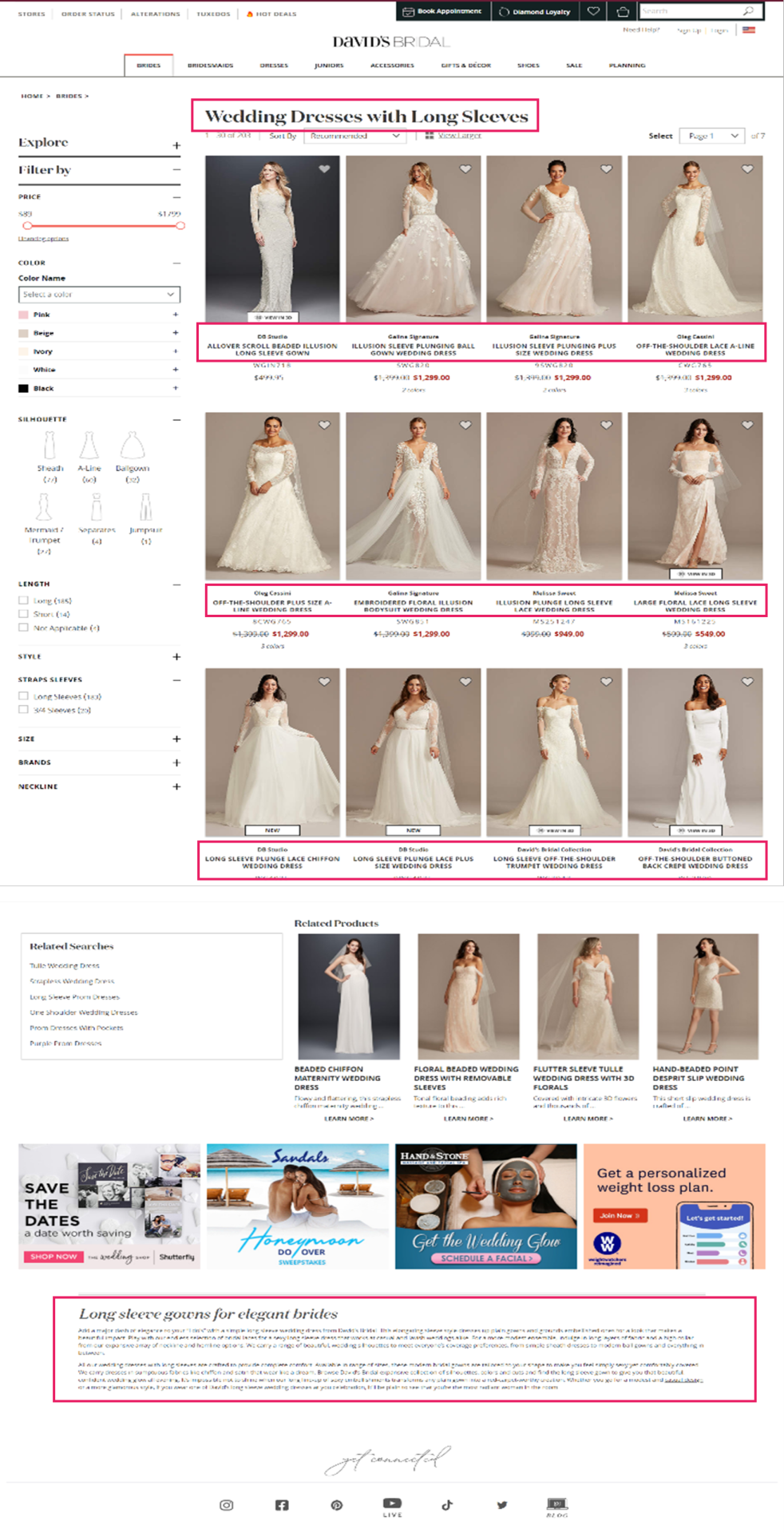
6. Provide accessibility and build page authority
Once you’ve opened up your new facet Product Listing Pages, you need to begin cultivating link equity towards them. This will ensure that they don’t exist as orphan URLs with no PageRank:
Ensure they’re referenced in your product XML sitemap.
If you have one feature per facet URL, then add them to your faceted navigation across CLP and Product Listing Page pages.
If you have two or more features per facet URL, then create a “Popular Searches” or “Related Searches” option within your CLPs.
Utilize your mega menu to showcase your new category landing pages. This will not only allow you to direct a large proportion of link equity, but it will also secure the highest click-through rate amongst your visitors.
Integrate your editorial strategy by creating engaging content with in-copy links. Think about how you can use descriptive long-tail anchor text about the Product Listing Page you want to link to rather than relying on “click here” or “see more”.
Connect to them via href links so you’re not solely relying on links from the main navigation or content hyperlinks. As this is difficult to do at scale, it can be done through modules such as “related categories”, “other subcategories”, “related products”, etc.
Devise strategic outreach campaigns that will secure quality, external backlinks to them.
Implementing this holistic and robust strategy will help you to secure exponential growth from your new commercial landing pages.
Conclusion
There is a great deal of organic opportunity that exists within your faceted navigation if you begin to leverage mid- and long-tail search terms.
Seek out the opportunity from extended keyword research and competitor analysis before deciding which variants fulfill consumer demands and deliver optimal organic sessions and onsite conversions. Configure a single faceted URL for each opportunity and open them up for crawl and indexation. Ensure PageRank is distributed to them (both internally and externally) and develop your landing page content in line with quality optimization practices. This approach will help you to avoid having crawl inefficiencies, over indexation, cannibalization, or having thin doorway pages. In turn, your website will be better suited to attract highly-targeted users and guide them down the purchase funnel.
Maximizing UX and reducing reliance on other marketing channels means that your faceted navigation can truly deliver organic ROI. We have seen this work for our clients.
0 notes
Text
Fulfill Untapped Customer Demands Through Your Faceted Navigation
Faceted navigation allows customers to narrow down search results based on specific product attributes. They typically exist on Product Listing Pages (PLPs) and are a great way to help users intuitively discover products but managing this filtering system is a common SEO challenge. Crawling and indexation need to be controlled.
However, if we look beyond their inherent functionality, facets can offer us considerable potential. By centering your secondary navigation on long-tail keyword opportunities, you’ll be able to strategically utilize consumer intent, secure additional web conversions, and boost revenue levels.
Match consumer intent with long-tail search queries
Having an established brand and a solid domain backlink profile won’t guarantee success. This is great news for smaller brands, as industry giants aren’t necessarily going to win at this game.
If we search for “long sleeve wedding dresses”, we can see how David’s Bridal’s optimized facet page (Domain Authority: 67/100, Page Authority: 47 / 100) has obtained the top ranking position, while Nordstrom’s result (Domain Authority: 87/100, Page Authority: 39/100) appears in the third position for this particular query. We’ll take a look at what makes this page so effective later.
When looking at how we can optimize faceted navigations, it’s important to recognize that product attributes convey consumer needs and aspirations. If, for example, I’m looking for a wedding dress, then I may tailor my search by the color, fabric, neckline shape, and the sleeve length.
According to the search demand curve, long-tail queries account for up to 70% of all organic searches. They are highly targeted queries that offer big traffic-driving opportunities.
In the last few years, we’ve seen a big shift in the industry towards capitalizing this intent with long-form content. Blog articles and style guides have become the go-to methods for many to capture these visitors, as we can see from the examples taken from Marks & Spencers’ "Inspire Me" section:

People often look for inspiration when they’re shopping, and these pages provide an effective way to add more internal links to category and product pages. But relying on this approach is one-dimensional, given that these deeper content pages tend to have lower PageRank. An extensive amount of time and effort will, therefore, be required to achieve the desired result.
In comparison, Product Listing Pages usually target broader search terms, and faceted navigations typically exist as passive functions. This is because they’re often blocked from crawlers, making them devoid of any SEO value. Waterstones (a well-known British bookstore) is one retailer that applies this rule for their on-page filters:
In this particular example, I’ve applied a filter to only show me books for 5 – 8 year olds, but the appended URL (https://ift.tt/3xrpOJS) is blocked in the robots.txt file. This is going to prevent such pages from being served in the SERPs despite them having the potential to meet specific customer needs. This shows that there can be a fundamental disconnect in matching customer intent to the pages we’re providing them in the organic results.
From the diagram below, we can see how editorial content typically focuses on the “awareness” and “interest” stages, whilst Product Listing Pages tend to be more in line with the “consideration” and “purchase” phases:
Serving the right content to users throughout their buying journey is pivotal to success. For many retailers, competitors are continuing to prioritize broader, high-volume keywords in saturated markets. They’re targeting the same terms to secure a proportion of the same search traffic. This is a very challenging prospect to face, and without carving out a gap in the marketplace, they won’t necessarily deliver the results they seek to secure. Likewise, relying on informational guides to target long-tail keywords means that you’re missing a large percentage of users who have very specific buying requirements. Yes, they’re ready to make a purchase!
By shifting your focus to address your customer’s real needs and expectations, you’ll be able to deliver a satisfying, frictionless experience at every interaction and all the way through to that final purchase.
The solution
Step 1: Conduct long-tail keyword research
Build a really comprehensive view of your potential customers by harnessing data from a variety of sources, including:
a) Keyword research tools like Moz, Google Keyword Planner, and Answer The Public.
b) The SERPs — get inspiration from the auto-suggest results, People Also Ask, and the related search links at the bottom of the page.
c) Competitor activity — aside from using SEO monitoring software, you can use a data mining extension tool like Scraper, which will extract faceted options directly from competitor Product Listing Pages. These tools are often free to download and allow you to quickly transfer product categories.
d) Your Google Search Console, Analytics, and PPC accounts to determine which keywords and URLs are securing the highest number of visits and web conversions. Internal search data can also give you great consumer insights.
e) Speak to your merchandising team to understand product demands and fulfillment capabilities.
Step 2: Group into meaningful sub-topics
Once you’ve collated all this information into a spreadsheet, you’ll be able to discover long-tail, consideration-orientated keywords. While individually they may not boast huge monthly search estimates, they can collectively highlight where purchase intentions can be better fulfilled.
To help illustrate this point, we can look at a small subset of lingerie keywords and the facets the searches represent:
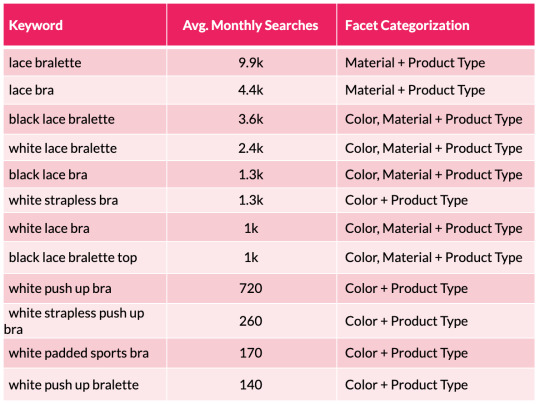
From the table above we can quickly see a pattern emerging with color and material variations appearing across the search terms. We can then substantiate this information with session and revenue estimates with the use of a recognized CTR model. This enables us to help forecast the potential organic uplift and quantify the size of the prize for a number of different scenarios that are on offer from each new facet combination. This may include estimations for securing position 10, 7, 5, 3 and 1 in Google.
One thing to note here is that it’s worth excluding synonyms, as they will falsely inflate your calculations. An example here would be to exclude “storage drawers” (22.2k monthly searchers) when reviewing the performance for “chest of drawers” (201k m/s). Including both variants will cause a false positive result and will lead you to draw incorrect conclusions.
Step 3: Dig deeper into broader terms around offers, ratings, and price
These product filters are found in the “Sort” dropdown box and, from my experience, these are set to “noindex” from the outset as they simply allow users to re-order page results. Certainly, content management systems like Shopify and Shopware have this as a default.
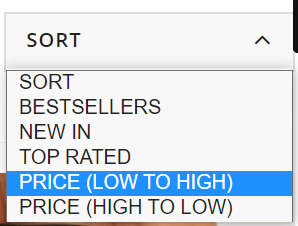
This makes sense since their purpose is to allow visitors to simply sort or narrow page content rather than offering alternative results and additional value (which is offered through faceted navigation). As such, filter typically produce duplicate results which should not be discoverable beyond the immediate moment. But this hard-and-fast rule doesn’t always apply perfectly in the real world. This is why we need to look at our individual industries and understand what’s important to our unique set of customers.
If we look at the world of gifting, we often see people shopping with a particular budget in mind. Therefore, terms like “birthday gift under £20” (40 m/s) or “Secret Santa gift under £10” (2.9k m/s) are reasonably common, and opening up relevant listing pages could be useful for shoppers.
Step 4: The technical steps
Facet taxonomies are hugely complex and the number of attributes that can be strung together increases with the size of the domain. We, therefore, need to carefully manage the flood gates and mitigate against any potential risks including crawl inefficiencies and link equity dilution.
We can do this by:
1. Avoiding thin/doorway pages by regularly re-assessing your product offering. For instance, you may consider there to be little value in creating a new listings page if you’re selling a very small range of low price point products. In this case, you may decide against opening up an additional Product Listing Page when you sell as few as 10 eligible products. However, this is not a fixed rule, so it’s quite possible that your criteria may be lower for particular product lines. Either way, these numbers will change over time. Consider seasonal trends, when new collections are launched, and when they become discontinued. Setting up a product retirement strategy to manage expired products and categories at scale in parallel with this step is also highly recommended.
2. Prevent content cannibalization by arranging selected facets according to their value and significance. “Size” is very important for some electrical goods like TVs, laptops, and cameras, but is less so for beauty accessories or vacuum cleaners. You must also make sure page content is distinctive and reflects the focus of your chosen facet(s). Refer to step 5 for more details.
3. Follow the sequence in which adjectives and facets are typically selected by your customers. This can vary depending on where your audience lives. So, whilst products generally have five or more distinguishable features, English vernacular determines that we use more than four adjectives (e.g. size + color + material + shape) to describe something.
4. Control the controllables by dealing with overlapping variations. This typically occurs when multiples co-exist and each exhibits good search metrics. For instance, it’s reasonable for someone to simultaneously look for several color and/or fabric combinations in the different ways below.

When this situation occurs, we should follow the same linguistic rules as above and choose a preferred sequence. In this case, it would be color + material + product type.
In comparison to the noindex tag suggested for on-page filters you should canonicalize unnecessary facets to their parent page (remembering that this is merely a hint and not a directive). This will enable you to control how crawlers deal with highly comparable result pages and will, therefore, help to prevent your site from being demoted in the SERPs. Dynamic search parameters should continue to be defined with a “noindex, nofollow” meta robots tag, disallowed in the robots.txt file, and configured through Google’s URL parameter tool (within your Search Console account) to tell crawlers the purpose of your parameters and how you would like them to be treated. This is a helpful guide on parameter handling for Googlebots, but bear in mind that this last tip won’t influence how Bing or Yahoo user-agents interpret these pages.
5. Open your facets in phases and cultivate it into a test-and-learn process. This will enable you to identify issues a lot sooner and implement facet-wide solutions in a timely manner. Without having to unravel these additional layers of complexity, problems such as crawl inefficiencies, PageRank dilution, or excessive indexation can be swiftly resolved.
To show you what this could look like, I’ve provided a phasing plan that was created for one of our e-commerce clients. Our research showed a significant SEO opportunity for opening up some of the facets and filters: potential +£263Kpcm for the “colour + type” facet (UK):
What’s more, when we extended our forecast to include other facet combinations, we calculated an additional revenue opportunity of up to +£207K/pcm (before filtering out combinations with no products offering).
Step 5: Optimize your facet URLs
Optimize your new facet category URLs to establish relevancy for your selected search terms. The key on-page elements to focus on include:
URL
Page title
Breadcrumb anchor texts
H tags
Content snippets (e.g. introductory text and FAQ copy)
Image ALT texts
Product names
Link out to similar facet category pages (i.e. via a “You May Also Like” feature box)
David’s Bridal is a good example of a retailer that has done this well. Looking back at the ‘Long Sleeve Wedding Dress’ Product Listing Page, we can see that they’ve curated unique content and followed fundamental optimization tactics on the landing page in a way that feels helpful to the user.
URL: davidsbridal.com/long-sleeve-wedding-dresses
Page Title: Long Sleeve Wedding Dresses & Gowns | David's Bridal
Meta Description: Do you dream of wearing a long sleeve wedding dress on your big day? Shop David's Bridal wide variety of wedding gowns with sleeves in lace & other designs!
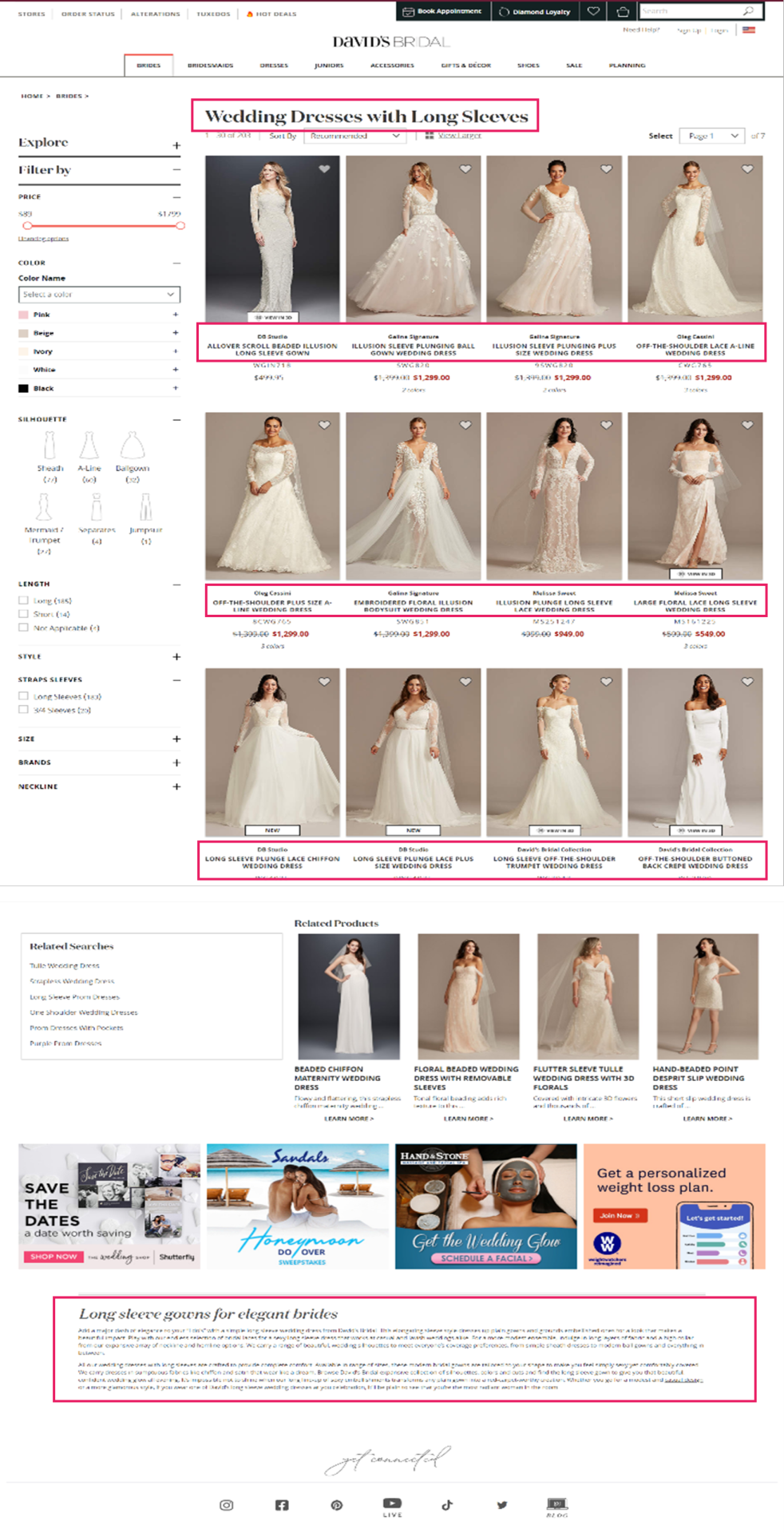
6. Provide accessibility and build page authority
Once you’ve opened up your new facet Product Listing Pages, you need to begin cultivating link equity towards them. This will ensure that they don’t exist as orphan URLs with no PageRank:
Ensure they’re referenced in your product XML sitemap.
If you have one feature per facet URL, then add them to your faceted navigation across CLP and Product Listing Page pages.
If you have two or more features per facet URL, then create a “Popular Searches” or “Related Searches” option within your CLPs.
Utilize your mega menu to showcase your new category landing pages. This will not only allow you to direct a large proportion of link equity, but it will also secure the highest click-through rate amongst your visitors.
Integrate your editorial strategy by creating engaging content with in-copy links. Think about how you can use descriptive long-tail anchor text about the Product Listing Page you want to link to rather than relying on “click here” or “see more”.
Connect to them via href links so you’re not solely relying on links from the main navigation or content hyperlinks. As this is difficult to do at scale, it can be done through modules such as “related categories”, “other subcategories”, “related products”, etc.
Devise strategic outreach campaigns that will secure quality, external backlinks to them.
Implementing this holistic and robust strategy will help you to secure exponential growth from your new commercial landing pages.
Conclusion
There is a great deal of organic opportunity that exists within your faceted navigation if you begin to leverage mid- and long-tail search terms.
Seek out the opportunity from extended keyword research and competitor analysis before deciding which variants fulfill consumer demands and deliver optimal organic sessions and onsite conversions. Configure a single faceted URL for each opportunity and open them up for crawl and indexation. Ensure PageRank is distributed to them (both internally and externally) and develop your landing page content in line with quality optimization practices. This approach will help you to avoid having crawl inefficiencies, over indexation, cannibalization, or having thin doorway pages. In turn, your website will be better suited to attract highly-targeted users and guide them down the purchase funnel.
Maximizing UX and reducing reliance on other marketing channels means that your faceted navigation can truly deliver organic ROI. We have seen this work for our clients.
0 notes
Text
Fulfill Untapped Customer Demands Through Your Faceted Navigation
Faceted navigation allows customers to narrow down search results based on specific product attributes. They typically exist on Product Listing Pages (PLPs) and are a great way to help users intuitively discover products but managing this filtering system is a common SEO challenge. Crawling and indexation need to be controlled.
However, if we look beyond their inherent functionality, facets can offer us considerable potential. By centering your secondary navigation on long-tail keyword opportunities, you’ll be able to strategically utilize consumer intent, secure additional web conversions, and boost revenue levels.
Match consumer intent with long-tail search queries
Having an established brand and a solid domain backlink profile won’t guarantee success. This is great news for smaller brands, as industry giants aren’t necessarily going to win at this game.
If we search for “long sleeve wedding dresses”, we can see how David’s Bridal’s optimized facet page (Domain Authority: 67/100, Page Authority: 47 / 100) has obtained the top ranking position, while Nordstrom’s result (Domain Authority: 87/100, Page Authority: 39/100) appears in the third position for this particular query. We’ll take a look at what makes this page so effective later.
When looking at how we can optimize faceted navigations, it’s important to recognize that product attributes convey consumer needs and aspirations. If, for example, I’m looking for a wedding dress, then I may tailor my search by the color, fabric, neckline shape, and the sleeve length.
According to the search demand curve, long-tail queries account for up to 70% of all organic searches. They are highly targeted queries that offer big traffic-driving opportunities.
In the last few years, we’ve seen a big shift in the industry towards capitalizing this intent with long-form content. Blog articles and style guides have become the go-to methods for many to capture these visitors, as we can see from the examples taken from Marks & Spencers’ "Inspire Me" section:

People often look for inspiration when they’re shopping, and these pages provide an effective way to add more internal links to category and product pages. But relying on this approach is one-dimensional, given that these deeper content pages tend to have lower PageRank. An extensive amount of time and effort will, therefore, be required to achieve the desired result.
In comparison, Product Listing Pages usually target broader search terms, and faceted navigations typically exist as passive functions. This is because they’re often blocked from crawlers, making them devoid of any SEO value. Waterstones (a well-known British bookstore) is one retailer that applies this rule for their on-page filters:
In this particular example, I’ve applied a filter to only show me books for 5 – 8 year olds, but the appended URL (https://ift.tt/3xrpOJS) is blocked in the robots.txt file. This is going to prevent such pages from being served in the SERPs despite them having the potential to meet specific customer needs. This shows that there can be a fundamental disconnect in matching customer intent to the pages we’re providing them in the organic results.
From the diagram below, we can see how editorial content typically focuses on the “awareness” and “interest” stages, whilst Product Listing Pages tend to be more in line with the “consideration” and “purchase” phases:
Serving the right content to users throughout their buying journey is pivotal to success. For many retailers, competitors are continuing to prioritize broader, high-volume keywords in saturated markets. They’re targeting the same terms to secure a proportion of the same search traffic. This is a very challenging prospect to face, and without carving out a gap in the marketplace, they won’t necessarily deliver the results they seek to secure. Likewise, relying on informational guides to target long-tail keywords means that you’re missing a large percentage of users who have very specific buying requirements. Yes, they’re ready to make a purchase!
By shifting your focus to address your customer’s real needs and expectations, you’ll be able to deliver a satisfying, frictionless experience at every interaction and all the way through to that final purchase.
The solution
Step 1: Conduct long-tail keyword research
Build a really comprehensive view of your potential customers by harnessing data from a variety of sources, including:
a) Keyword research tools like Moz, Google Keyword Planner, and Answer The Public.
b) The SERPs — get inspiration from the auto-suggest results, People Also Ask, and the related search links at the bottom of the page.
c) Competitor activity — aside from using SEO monitoring software, you can use a data mining extension tool like Scraper, which will extract faceted options directly from competitor Product Listing Pages. These tools are often free to download and allow you to quickly transfer product categories.
d) Your Google Search Console, Analytics, and PPC accounts to determine which keywords and URLs are securing the highest number of visits and web conversions. Internal search data can also give you great consumer insights.
e) Speak to your merchandising team to understand product demands and fulfillment capabilities.
Step 2: Group into meaningful sub-topics
Once you’ve collated all this information into a spreadsheet, you’ll be able to discover long-tail, consideration-orientated keywords. While individually they may not boast huge monthly search estimates, they can collectively highlight where purchase intentions can be better fulfilled.
To help illustrate this point, we can look at a small subset of lingerie keywords and the facets the searches represent:

From the table above we can quickly see a pattern emerging with color and material variations appearing across the search terms. We can then substantiate this information with session and revenue estimates with the use of a recognized CTR model. This enables us to help forecast the potential organic uplift and quantify the size of the prize for a number of different scenarios that are on offer from each new facet combination. This may include estimations for securing position 10, 7, 5, 3 and 1 in Google.
One thing to note here is that it’s worth excluding synonyms, as they will falsely inflate your calculations. An example here would be to exclude “storage drawers” (22.2k monthly searchers) when reviewing the performance for “chest of drawers” (201k m/s). Including both variants will cause a false positive result and will lead you to draw incorrect conclusions.
Step 3: Dig deeper into broader terms around offers, ratings, and price
These product filters are found in the “Sort” dropdown box and, from my experience, these are set to “noindex” from the outset as they simply allow users to re-order page results. Certainly, content management systems like Shopify and Shopware have this as a default.
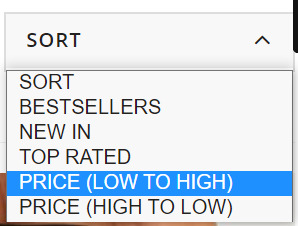
This makes sense since their purpose is to allow visitors to simply sort or narrow page content rather than offering alternative results and additional value (which is offered through faceted navigation). As such, filter typically produce duplicate results which should not be discoverable beyond the immediate moment. But this hard-and-fast rule doesn’t always apply perfectly in the real world. This is why we need to look at our individual industries and understand what’s important to our unique set of customers.
If we look at the world of gifting, we often see people shopping with a particular budget in mind. Therefore, terms like “birthday gift under £20” (40 m/s) or “Secret Santa gift under £10” (2.9k m/s) are reasonably common, and opening up relevant listing pages could be useful for shoppers.
Step 4: The technical steps
Facet taxonomies are hugely complex and the number of attributes that can be strung together increases with the size of the domain. We, therefore, need to carefully manage the flood gates and mitigate against any potential risks including crawl inefficiencies and link equity dilution.
We can do this by:
1. Avoiding thin/doorway pages by regularly re-assessing your product offering. For instance, you may consider there to be little value in creating a new listings page if you’re selling a very small range of low price point products. In this case, you may decide against opening up an additional Product Listing Page when you sell as few as 10 eligible products. However, this is not a fixed rule, so it’s quite possible that your criteria may be lower for particular product lines. Either way, these numbers will change over time. Consider seasonal trends, when new collections are launched, and when they become discontinued. Setting up a product retirement strategy to manage expired products and categories at scale in parallel with this step is also highly recommended.
2. Prevent content cannibalization by arranging selected facets according to their value and significance. “Size” is very important for some electrical goods like TVs, laptops, and cameras, but is less so for beauty accessories or vacuum cleaners. You must also make sure page content is distinctive and reflects the focus of your chosen facet(s). Refer to step 5 for more details.
3. Follow the sequence in which adjectives and facets are typically selected by your customers. This can vary depending on where your audience lives. So, whilst products generally have five or more distinguishable features, English vernacular determines that we use more than four adjectives (e.g. size + color + material + shape) to describe something.
4. Control the controllables by dealing with overlapping variations. This typically occurs when multiples co-exist and each exhibits good search metrics. For instance, it’s reasonable for someone to simultaneously look for several color and/or fabric combinations in the different ways below.

When this situation occurs, we should follow the same linguistic rules as above and choose a preferred sequence. In this case, it would be color + material + product type.
In comparison to the noindex tag suggested for on-page filters you should canonicalize unnecessary facets to their parent page (remembering that this is merely a hint and not a directive). This will enable you to control how crawlers deal with highly comparable result pages and will, therefore, help to prevent your site from being demoted in the SERPs. Dynamic search parameters should continue to be defined with a “noindex, nofollow” meta robots tag, disallowed in the robots.txt file, and configured through Google’s URL parameter tool (within your Search Console account) to tell crawlers the purpose of your parameters and how you would like them to be treated. This is a helpful guide on parameter handling for Googlebots, but bear in mind that this last tip won’t influence how Bing or Yahoo user-agents interpret these pages.
5. Open your facets in phases and cultivate it into a test-and-learn process. This will enable you to identify issues a lot sooner and implement facet-wide solutions in a timely manner. Without having to unravel these additional layers of complexity, problems such as crawl inefficiencies, PageRank dilution, or excessive indexation can be swiftly resolved.
To show you what this could look like, I’ve provided a phasing plan that was created for one of our e-commerce clients. Our research showed a significant SEO opportunity for opening up some of the facets and filters: potential +£263Kpcm for the “colour + type” facet (UK):
What’s more, when we extended our forecast to include other facet combinations, we calculated an additional revenue opportunity of up to +£207K/pcm (before filtering out combinations with no products offering).
Step 5: Optimize your facet URLs
Optimize your new facet category URLs to establish relevancy for your selected search terms. The key on-page elements to focus on include:
URL
Page title
Breadcrumb anchor texts
H tags
Content snippets (e.g. introductory text and FAQ copy)
Image ALT texts
Product names
Link out to similar facet category pages (i.e. via a “You May Also Like” feature box)
David’s Bridal is a good example of a retailer that has done this well. Looking back at the ‘Long Sleeve Wedding Dress’ Product Listing Page, we can see that they’ve curated unique content and followed fundamental optimization tactics on the landing page in a way that feels helpful to the user.
URL: davidsbridal.com/long-sleeve-wedding-dresses
Page Title: Long Sleeve Wedding Dresses & Gowns | David's Bridal
Meta Description: Do you dream of wearing a long sleeve wedding dress on your big day? Shop David's Bridal wide variety of wedding gowns with sleeves in lace & other designs!
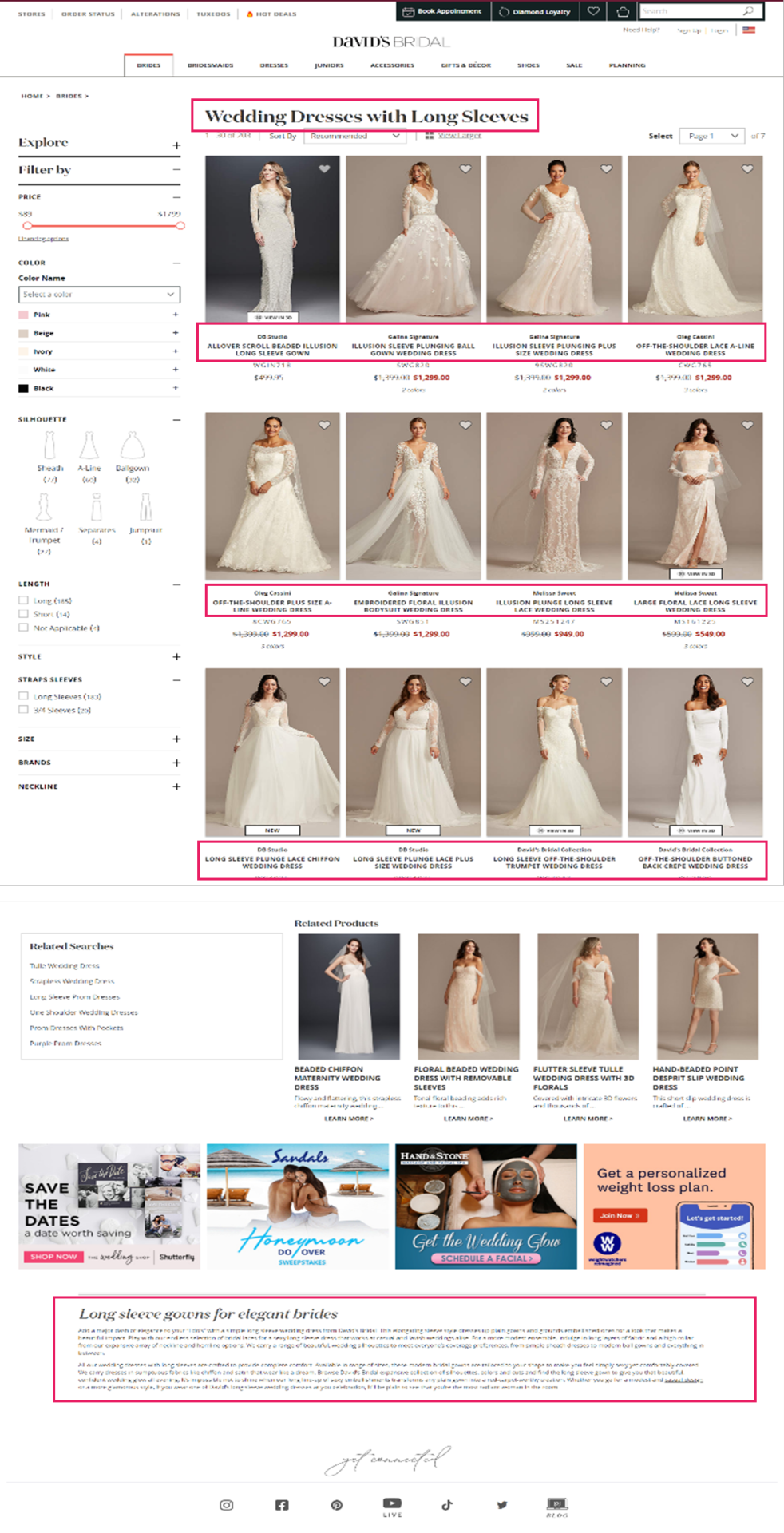
6. Provide accessibility and build page authority
Once you’ve opened up your new facet Product Listing Pages, you need to begin cultivating link equity towards them. This will ensure that they don’t exist as orphan URLs with no PageRank:
Ensure they’re referenced in your product XML sitemap.
If you have one feature per facet URL, then add them to your faceted navigation across CLP and Product Listing Page pages.
If you have two or more features per facet URL, then create a “Popular Searches” or “Related Searches” option within your CLPs.
Utilize your mega menu to showcase your new category landing pages. This will not only allow you to direct a large proportion of link equity, but it will also secure the highest click-through rate amongst your visitors.
Integrate your editorial strategy by creating engaging content with in-copy links. Think about how you can use descriptive long-tail anchor text about the Product Listing Page you want to link to rather than relying on “click here” or “see more”.
Connect to them via href links so you’re not solely relying on links from the main navigation or content hyperlinks. As this is difficult to do at scale, it can be done through modules such as “related categories”, “other subcategories”, “related products”, etc.
Devise strategic outreach campaigns that will secure quality, external backlinks to them.
Implementing this holistic and robust strategy will help you to secure exponential growth from your new commercial landing pages.
Conclusion
There is a great deal of organic opportunity that exists within your faceted navigation if you begin to leverage mid- and long-tail search terms.
Seek out the opportunity from extended keyword research and competitor analysis before deciding which variants fulfill consumer demands and deliver optimal organic sessions and onsite conversions. Configure a single faceted URL for each opportunity and open them up for crawl and indexation. Ensure PageRank is distributed to them (both internally and externally) and develop your landing page content in line with quality optimization practices. This approach will help you to avoid having crawl inefficiencies, over indexation, cannibalization, or having thin doorway pages. In turn, your website will be better suited to attract highly-targeted users and guide them down the purchase funnel.
Maximizing UX and reducing reliance on other marketing channels means that your faceted navigation can truly deliver organic ROI. We have seen this work for our clients.
#túi_giấy_epacking_việt_nam #túi_giấy_epacking #in_túi_giấy_giá_rẻ #in_túi_giấy #epackingvietnam #tuigiayepacking
0 notes
Text
Fulfill Untapped Customer Demands Through Your Faceted Navigation
Faceted navigation allows customers to narrow down search results based on specific product attributes. They typically exist on Product Listing Pages (PLPs) and are a great way to help users intuitively discover products but managing this filtering system is a common SEO challenge. Crawling and indexation need to be controlled.
However, if we look beyond their inherent functionality, facets can offer us considerable potential. By centering your secondary navigation on long-tail keyword opportunities, you’ll be able to strategically utilize consumer intent, secure additional web conversions, and boost revenue levels.
Match consumer intent with long-tail search queries
Having an established brand and a solid domain backlink profile won’t guarantee success. This is great news for smaller brands, as industry giants aren’t necessarily going to win at this game.
If we search for “long sleeve wedding dresses”, we can see how David’s Bridal’s optimized facet page (Domain Authority: 67/100, Page Authority: 47 / 100) has obtained the top ranking position, while Nordstrom’s result (Domain Authority: 87/100, Page Authority: 39/100) appears in the third position for this particular query. We’ll take a look at what makes this page so effective later.
When looking at how we can optimize faceted navigations, it’s important to recognize that product attributes convey consumer needs and aspirations. If, for example, I’m looking for a wedding dress, then I may tailor my search by the color, fabric, neckline shape, and the sleeve length.
According to the search demand curve, long-tail queries account for up to 70% of all organic searches. They are highly targeted queries that offer big traffic-driving opportunities.
In the last few years, we’ve seen a big shift in the industry towards capitalizing this intent with long-form content. Blog articles and style guides have become the go-to methods for many to capture these visitors, as we can see from the examples taken from Marks & Spencers’ "Inspire Me" section:

People often look for inspiration when they’re shopping, and these pages provide an effective way to add more internal links to category and product pages. But relying on this approach is one-dimensional, given that these deeper content pages tend to have lower PageRank. An extensive amount of time and effort will, therefore, be required to achieve the desired result.
In comparison, Product Listing Pages usually target broader search terms, and faceted navigations typically exist as passive functions. This is because they’re often blocked from crawlers, making them devoid of any SEO value. Waterstones (a well-known British bookstore) is one retailer that applies this rule for their on-page filters:
In this particular example, I’ve applied a filter to only show me books for 5 – 8 year olds, but the appended URL (https://www.waterstones.com/category/childrens-teenage/facet/498) is blocked in the robots.txt file. This is going to prevent such pages from being served in the SERPs despite them having the potential to meet specific customer needs. This shows that there can be a fundamental disconnect in matching customer intent to the pages we’re providing them in the organic results.
From the diagram below, we can see how editorial content typically focuses on the “awareness” and “interest” stages, whilst Product Listing Pages tend to be more in line with the “consideration” and “purchase” phases:
Serving the right content to users throughout their buying journey is pivotal to success. For many retailers, competitors are continuing to prioritize broader, high-volume keywords in saturated markets. They’re targeting the same terms to secure a proportion of the same search traffic. This is a very challenging prospect to face, and without carving out a gap in the marketplace, they won’t necessarily deliver the results they seek to secure. Likewise, relying on informational guides to target long-tail keywords means that you’re missing a large percentage of users who have very specific buying requirements. Yes, they’re ready to make a purchase!
By shifting your focus to address your customer’s real needs and expectations, you’ll be able to deliver a satisfying, frictionless experience at every interaction and all the way through to that final purchase.
The solution
Step 1: Conduct long-tail keyword research
Build a really comprehensive view of your potential customers by harnessing data from a variety of sources, including:
a) Keyword research tools like Moz, Google Keyword Planner, and Answer The Public.
b) The SERPs — get inspiration from the auto-suggest results, People Also Ask, and the related search links at the bottom of the page.
c) Competitor activity — aside from using SEO monitoring software, you can use a data mining extension tool like Scraper, which will extract faceted options directly from competitor Product Listing Pages. These tools are often free to download and allow you to quickly transfer product categories.
d) Your Google Search Console, Analytics, and PPC accounts to determine which keywords and URLs are securing the highest number of visits and web conversions. Internal search data can also give you great consumer insights.
e) Speak to your merchandising team to understand product demands and fulfillment capabilities.
Step 2: Group into meaningful sub-topics
Once you’ve collated all this information into a spreadsheet, you’ll be able to discover long-tail, consideration-orientated keywords. While individually they may not boast huge monthly search estimates, they can collectively highlight where purchase intentions can be better fulfilled.
To help illustrate this point, we can look at a small subset of lingerie keywords and the facets the searches represent:
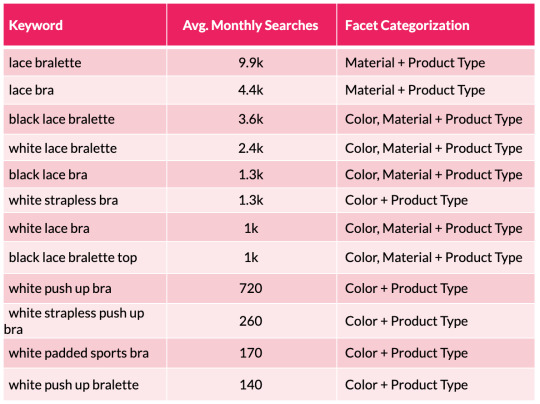
From the table above we can quickly see a pattern emerging with color and material variations appearing across the search terms. We can then substantiate this information with session and revenue estimates with the use of a recognized CTR model. This enables us to help forecast the potential organic uplift and quantify the size of the prize for a number of different scenarios that are on offer from each new facet combination. This may include estimations for securing position 10, 7, 5, 3 and 1 in Google.
One thing to note here is that it’s worth excluding synonyms, as they will falsely inflate your calculations. An example here would be to exclude “storage drawers” (22.2k monthly searchers) when reviewing the performance for “chest of drawers” (201k m/s). Including both variants will cause a false positive result and will lead you to draw incorrect conclusions.
Step 3: Dig deeper into broader terms around offers, ratings, and price
These product filters are found in the “Sort” dropdown box and, from my experience, these are set to “noindex” from the outset as they simply allow users to re-order page results. Certainly, content management systems like Shopify and Shopware have this as a default.
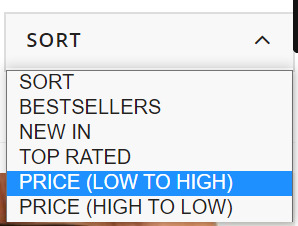
This makes sense since their purpose is to allow visitors to simply sort or narrow page content rather than offering alternative results and additional value (which is offered through faceted navigation). As such, filter typically produce duplicate results which should not be discoverable beyond the immediate moment. But this hard-and-fast rule doesn’t always apply perfectly in the real world. This is why we need to look at our individual industries and understand what’s important to our unique set of customers.
If we look at the world of gifting, we often see people shopping with a particular budget in mind. Therefore, terms like “birthday gift under £20” (40 m/s) or “Secret Santa gift under £10” (2.9k m/s) are reasonably common, and opening up relevant listing pages could be useful for shoppers.
Step 4: The technical steps
Facet taxonomies are hugely complex and the number of attributes that can be strung together increases with the size of the domain. We, therefore, need to carefully manage the flood gates and mitigate against any potential risks including crawl inefficiencies and link equity dilution.
We can do this by:
1. Avoiding thin/doorway pages by regularly re-assessing your product offering. For instance, you may consider there to be little value in creating a new listings page if you’re selling a very small range of low price point products. In this case, you may decide against opening up an additional Product Listing Page when you sell as few as 10 eligible products. However, this is not a fixed rule, so it’s quite possible that your criteria may be lower for particular product lines. Either way, these numbers will change over time. Consider seasonal trends, when new collections are launched, and when they become discontinued. Setting up a product retirement strategy to manage expired products and categories at scale in parallel with this step is also highly recommended.
2. Prevent content cannibalization by arranging selected facets according to their value and significance. “Size” is very important for some electrical goods like TVs, laptops, and cameras, but is less so for beauty accessories or vacuum cleaners. You must also make sure page content is distinctive and reflects the focus of your chosen facet(s). Refer to step 5 for more details.
3. Follow the sequence in which adjectives and facets are typically selected by your customers. This can vary depending on where your audience lives. So, whilst products generally have five or more distinguishable features, English vernacular determines that we use more than four adjectives (e.g. size + color + material + shape) to describe something.
4. Control the controllables by dealing with overlapping variations. This typically occurs when multiples co-exist and each exhibits good search metrics. For instance, it’s reasonable for someone to simultaneously look for several color and/or fabric combinations in the different ways below.
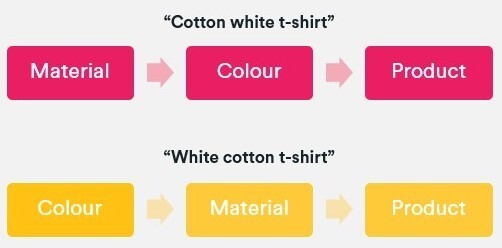
When this situation occurs, we should follow the same linguistic rules as above and choose a preferred sequence. In this case, it would be color + material + product type.
In comparison to the noindex tag suggested for on-page filters you should canonicalize unnecessary facets to their parent page (remembering that this is merely a hint and not a directive). This will enable you to control how crawlers deal with highly comparable result pages and will, therefore, help to prevent your site from being demoted in the SERPs. Dynamic search parameters should continue to be defined with a “noindex, nofollow” meta robots tag, disallowed in the robots.txt file, and configured through Google’s URL parameter tool (within your Search Console account) to tell crawlers the purpose of your parameters and how you would like them to be treated. This is a helpful guide on parameter handling for Googlebots, but bear in mind that this last tip won’t influence how Bing or Yahoo user-agents interpret these pages.
5. Open your facets in phases and cultivate it into a test-and-learn process. This will enable you to identify issues a lot sooner and implement facet-wide solutions in a timely manner. Without having to unravel these additional layers of complexity, problems such as crawl inefficiencies, PageRank dilution, or excessive indexation can be swiftly resolved.
To show you what this could look like, I’ve provided a phasing plan that was created for one of our e-commerce clients. Our research showed a significant SEO opportunity for opening up some of the facets and filters: potential +£263Kpcm for the “colour + type” facet (UK):
What’s more, when we extended our forecast to include other facet combinations, we calculated an additional revenue opportunity of up to +£207K/pcm (before filtering out combinations with no products offering).
Step 5: Optimize your facet URLs
Optimize your new facet category URLs to establish relevancy for your selected search terms. The key on-page elements to focus on include:
URL
Page title
Breadcrumb anchor texts
H tags
Content snippets (e.g. introductory text and FAQ copy)
Image ALT texts
Product names
Link out to similar facet category pages (i.e. via a “You May Also Like” feature box)
David’s Bridal is a good example of a retailer that has done this well. Looking back at the ‘Long Sleeve Wedding Dress’ Product Listing Page, we can see that they’ve curated unique content and followed fundamental optimization tactics on the landing page in a way that feels helpful to the user.
URL: davidsbridal.com/long-sleeve-wedding-dresses
Page Title: Long Sleeve Wedding Dresses & Gowns | David's Bridal
Meta Description: Do you dream of wearing a long sleeve wedding dress on your big day? Shop David's Bridal wide variety of wedding gowns with sleeves in lace & other designs!
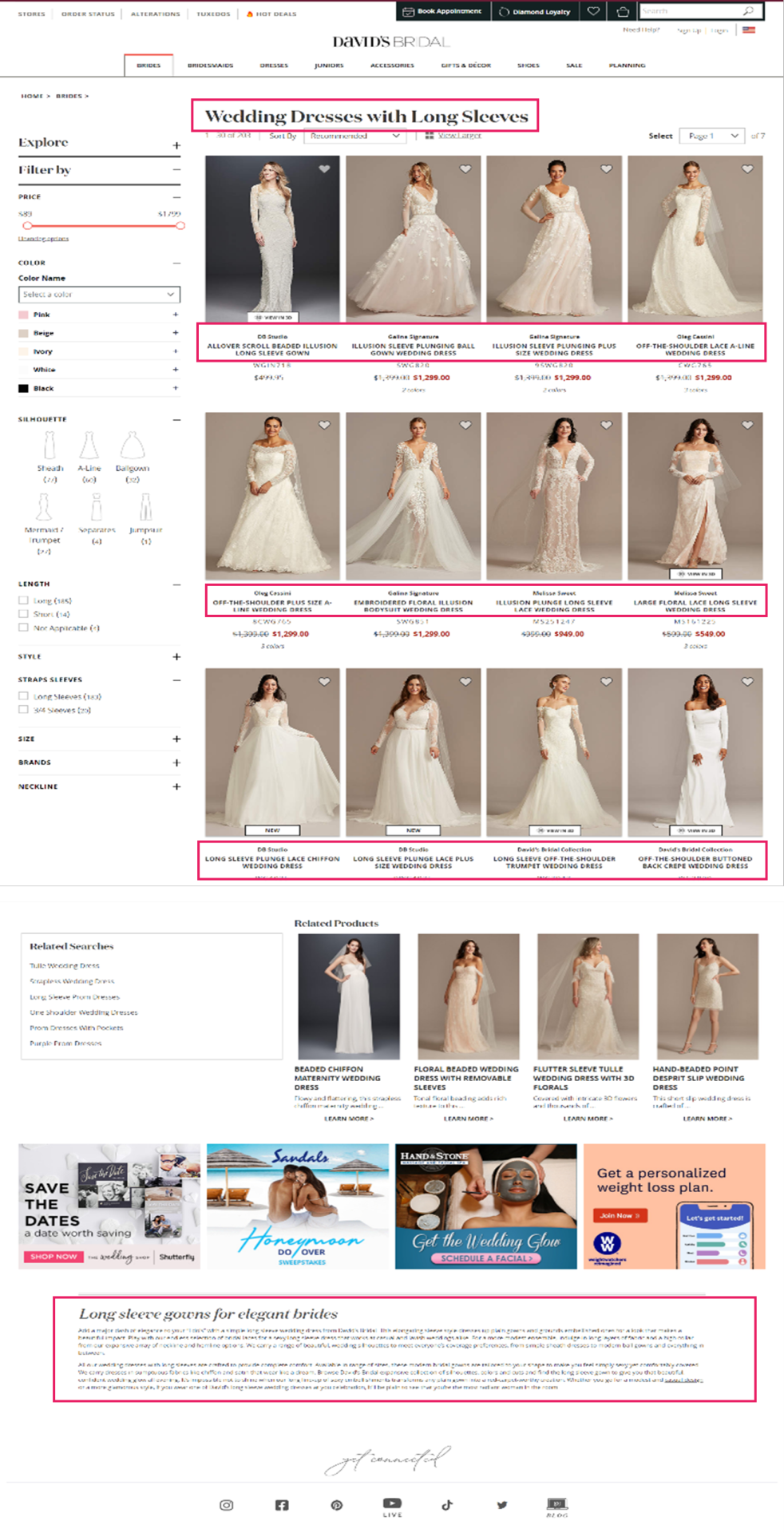
6. Provide accessibility and build page authority
Once you’ve opened up your new facet Product Listing Pages, you need to begin cultivating link equity towards them. This will ensure that they don’t exist as orphan URLs with no PageRank:
Ensure they’re referenced in your product XML sitemap.
If you have one feature per facet URL, then add them to your faceted navigation across CLP and Product Listing Page pages.
If you have two or more features per facet URL, then create a “Popular Searches” or “Related Searches” option within your CLPs.
Utilize your mega menu to showcase your new category landing pages. This will not only allow you to direct a large proportion of link equity, but it will also secure the highest click-through rate amongst your visitors.
Integrate your editorial strategy by creating engaging content with in-copy links. Think about how you can use descriptive long-tail anchor text about the Product Listing Page you want to link to rather than relying on “click here” or “see more”.
Connect to them via href links so you’re not solely relying on links from the main navigation or content hyperlinks. As this is difficult to do at scale, it can be done through modules such as “related categories”, “other subcategories”, “related products”, etc.
Devise strategic outreach campaigns that will secure quality, external backlinks to them.
Implementing this holistic and robust strategy will help you to secure exponential growth from your new commercial landing pages.
Conclusion
There is a great deal of organic opportunity that exists within your faceted navigation if you begin to leverage mid- and long-tail search terms.
Seek out the opportunity from extended keyword research and competitor analysis before deciding which variants fulfill consumer demands and deliver optimal organic sessions and onsite conversions. Configure a single faceted URL for each opportunity and open them up for crawl and indexation. Ensure PageRank is distributed to them (both internally and externally) and develop your landing page content in line with quality optimization practices. This approach will help you to avoid having crawl inefficiencies, over indexation, cannibalization, or having thin doorway pages. In turn, your website will be better suited to attract highly-targeted users and guide them down the purchase funnel.
Maximizing UX and reducing reliance on other marketing channels means that your faceted navigation can truly deliver organic ROI. We have seen this work for our clients.
0 notes